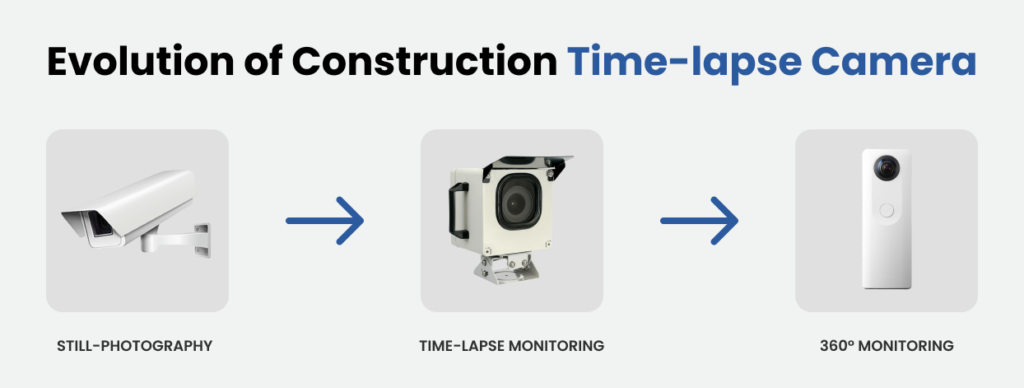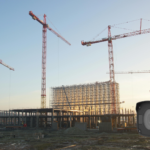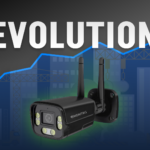There are two types of cameras in the construction industry, first is construction security camera and second is construction time-lapse camera. The construction camera and construction time-lapse camera are the terms used interchangeably very frequently. Then what about construction security camera? Construction security cameras or simply security cameras are those cameras integrated on project sites for surveillance purposes. In this blog post you will read the evolution of construction CCTV and time-lapse camera both.
Construction CCTV Camera
A construction security camera is the camera used to monitor and record the activities of a construction site from the perspective of maintaining safety and security at a jobsite. In the beginning, the Construction CCTV Cameras were introduced for surveillance purposes. But now they have evolved to much more, providing motion tracking, facial recognition, etc. Before starting with the detailed evolution of Construction CCTV cameras, you must know about the inception of CCTV cameras.
The History
The first CCTV camera was introduced by Russian physicist Léon Theremin in 1927. Afterward CCTV cameras launched to the commercial market in 1949. Since then it started being used for various industries for security purposes. There is no exact evidence that claims the first use of CCTV cameras in the construction industry. It is speculated that the CCTV camera was introduced to the construction industry in early 20’s as Construction Security Camera.
Evolution of Construction CCTV Camera
The present-day construction CCTV camera is not only restricted to surveillance. After some alterations and FTP protocol, the CCTV camera works as a time-lapse camera. Besides that, the CCTV camera has evolved and serves the following features to the construction industry.
- Motion detection
- Remote monitoring
- Facial recognition
- Thermal imaging
1. Motion Detection
The motion detection feature alerts the management when there is a movement on the site. Motion detection is suitable for security purposes in contrast to preventing extruders from entering the site.
The motion detection feature works on the pixel change phenomenon in the frame. When the camera detects those changes, it alerts with a built-in siren and remotely through SMS or mobile app alert.
2. Remote Monitoring
Advancements in technology, such as 4G or Wifi internet integration with Construction CCTV Camera, allow remote monitoring of the construction site in real-time, even through mobile apps. This implies fewer site visits are required and saves cost.
3. Facial recognition
Growing AI technology is becoming an integral part of every organization, and so is in the case of construction security cameras. Facial recognition feature prevents unknown persons from entering the site and works as an automated attendance management system.
4. Thermal Imaging
This feature is not available in regular CCTV cameras. Some advanced cameras are equipped with thermal imaging. It helps in detecting people even behind the walls.
Construction Time-lapse Camera
A construction time-lapse camera is the camera which takes images of the site at a fixed interval to record the progress over time. The construction time-lapse camera is used for the purpose of jobsite remote progress monitoring. The impact of construction time-lapse cameras has been undeniable for the past decade. In terms of photography, the construction time-lapse camera has evolved from still photography to 360-degree time-lapse videos.

The History
In 1897, time-lapse photography was introduced as a result of capturing images at an interval and stitching them together to form a video. But in the 1930s it started to gain attention after Dr. John Ott used it to document the plant growth.
Evolution of Construction Time-lapse Camera
Over the past decade the construction cameras have evolved with technological advancements such as IT infrastructure (remote monitoring possibility), and artificial intelligence (AI PPE Detection, People and workers’ counting, etc.).
1. Progress monitoring
The traditional progress monitoring methods are imprecise and require manual work. But with construction time-lapse cameras, the project managers can monitor the project progress remotely in real-time. Hence reduces the site’s visit cost and saves time.
2. Time-lapse Videos
Time-lapse videos are mesmerizing videos that show the months of progress in just a few minutes of video. These time-lapse videos have various utilizations, such as documents for progress review meetings and quick sharing with stakeholders for transparency to the project, and can be used for marketing purposes.
3. 360-degree time-lapse videos
Modern construction time-lapse cameras have evolved to provide a realistic 360-degree view of the site. You can obtain 360-degree images as well as 360-degree time-lapse videos. These tools enable project managers to make more precise decisions based on insights and site visuals. Besides regular time-lapse cameras, 360-degree construction time-lapse cameras have the following undoubted benefits:
- Comprehensive Site Coverage
- Enhanced Decision-Making
- Improved Communication
- Efficient Progress Tracking
4. AI videos analytics for PPE compliances
It is the AI revolution that is happening right now. Everyone is implementing AI in their work for various reasons. Similarly, AI has evolved in the construction industry. It provides image processing and video analytics to maintain PPE compliance at the jobsite. Maintaining PPE compliance uses AI to help the project manager keep the site safe. The AI PPE compliances include the detection of workers’ safety gear such as hard hats, vests, goggles, gloves, safety belts, and safety shoes, etc.
5. Construction vehicle and worker detection
AI is backing up image processing and video analytics to revolutionize the construction industry. AI processes the construction time-lapse camera images and detects the count of workers and construction vehicles present at the jobsite (in a particular image captured). It also categorizes the construction vehicles viz loader, crane, etc.
Conclusion
The construction industry has greatly benefited from the evolution of CCTV and time-lapse cameras. Construction CCTV cameras have advanced from simple surveillance tools to sophisticated systems with features like motion detection, remote monitoring, facial recognition, and thermal imaging, enhancing site security and efficiency. Simultaneously, construction time-lapse cameras have transitioned from still photography to 360-degree time-lapse videos, offering comprehensive progress monitoring, improved communication, and enhanced decision-making capabilities.




